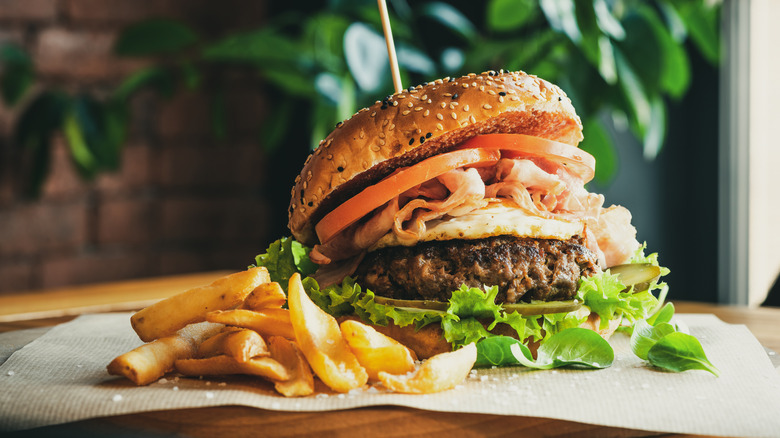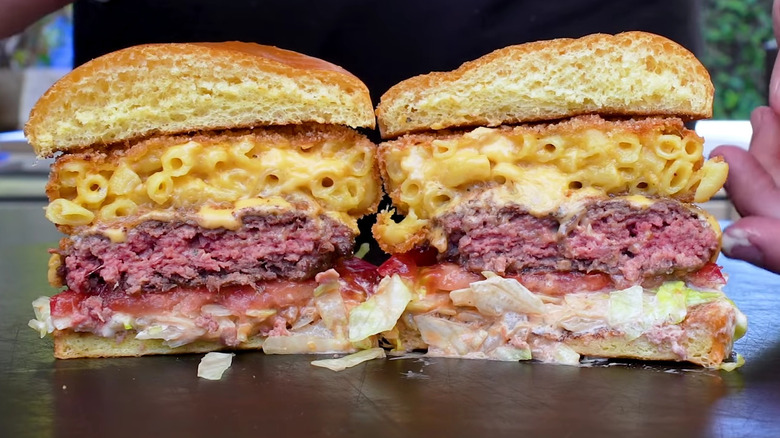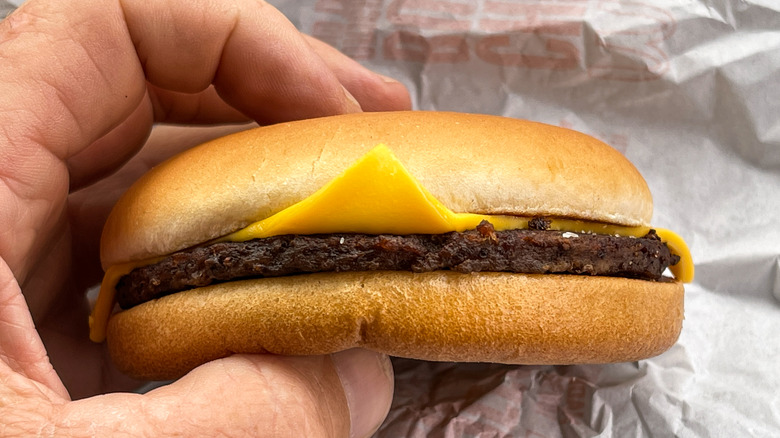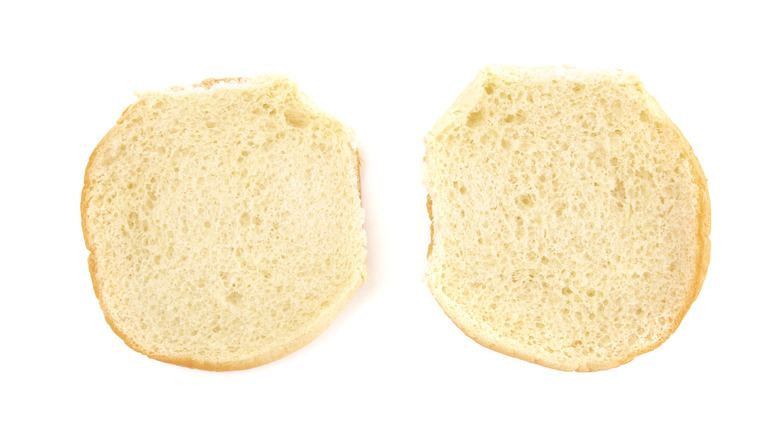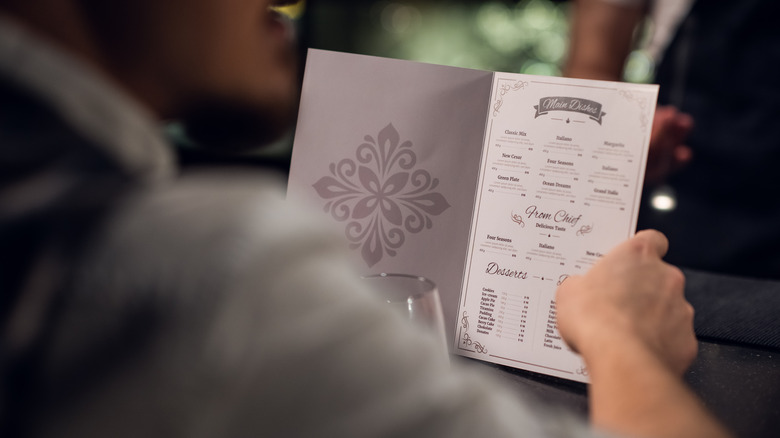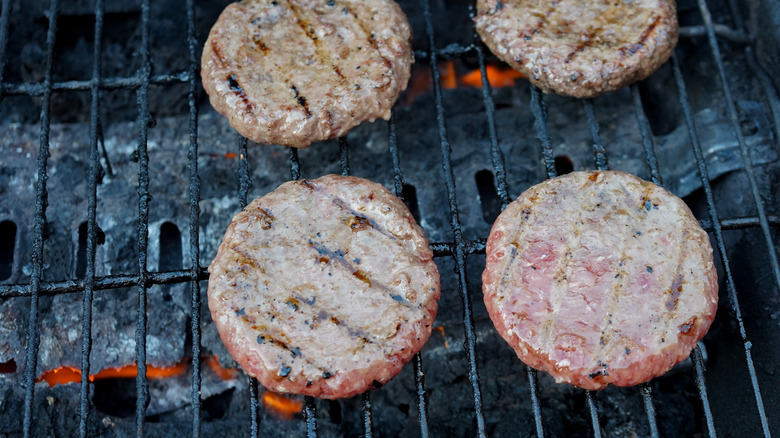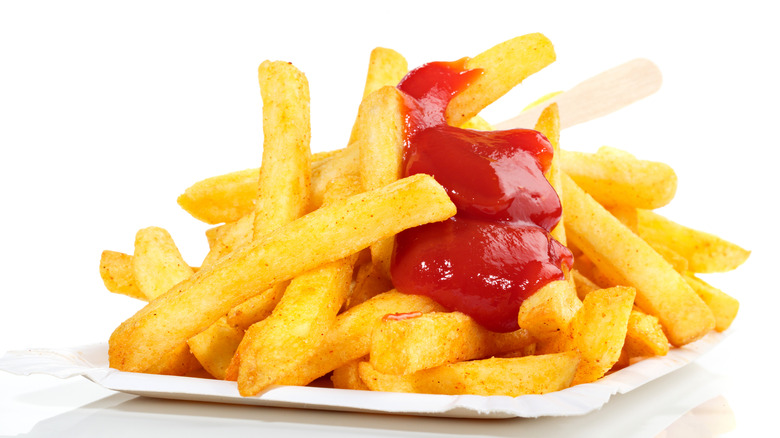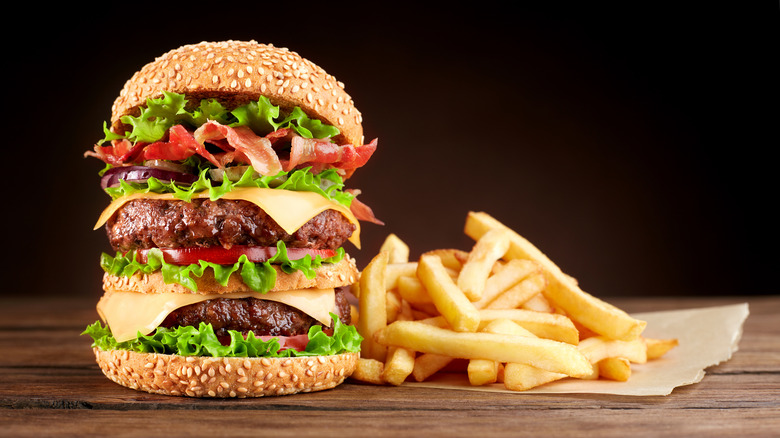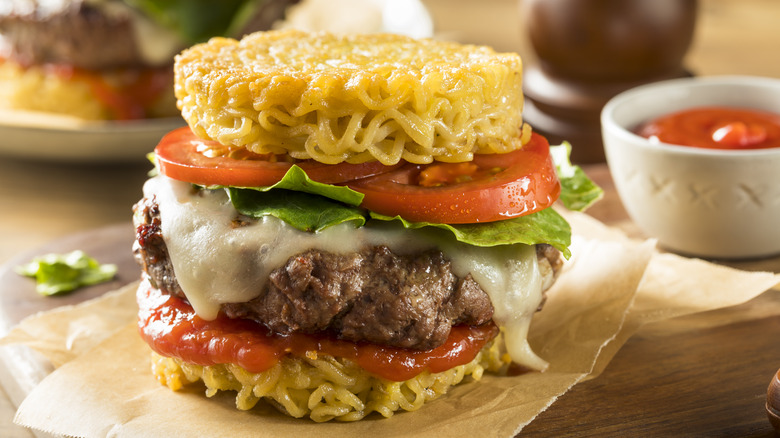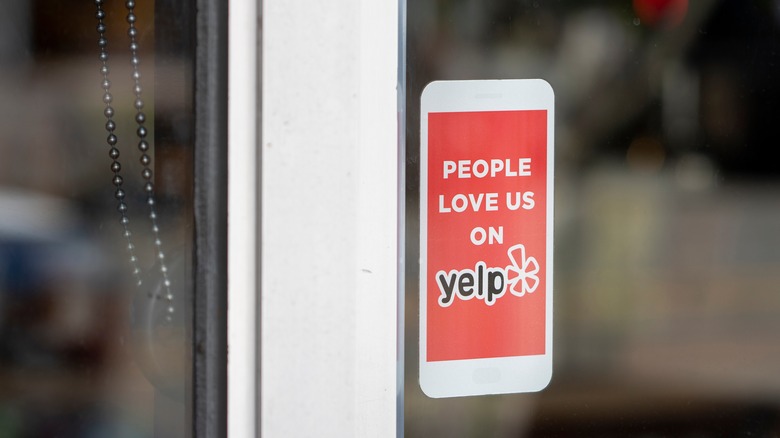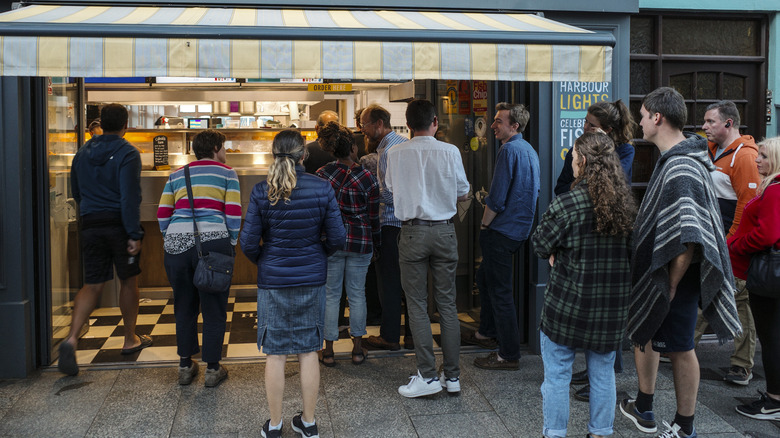12 Red Flags To Watch Out For At Burger Joints
Over the decades, hamburgers have become a symbol of the United States. Americans consume a huge number of burgers every year, around 50 billion. While many of these are cooked and eaten at home, burgers also play a large role in America's restaurant scene. There are many burger joints across the country – Ibis World estimates that the total stands at more than 90,000. California alone is home to over 30,000. You can find wagyu burgers that cost $5,000 and are served with bottles of expensive wine, and at the other end of the economic spectrum are the cheap and cheerful fast food burgers.
With such a diverse range of burgers available across America, eating a subpar one is a bitter disappointment. Yet, this is the reality for many Americans every day. So you don't have to join this disappointed lot, we've collated 12 red flags that indicate you might be about to eat at a bad burger restaurant. If, upon entering the burger joint, you spy a few of these, leave. After all, there are plenty of choices out there.
1. Crazy toppings
In a poll conducted by YouGov America, only 2% of respondents said they ate burgers without toppings. Consequently, toppings form an integral — and personal — part of the burger-eating experience. America's favorite burger toppings are simple ones: cheese, ketchup, and lettuce. That isn't to say these are the only options — bacon, avocado, and onions have a fair number of fans. But some American restaurants have developed a reputation for taking liberties with the word "toppings," lumping outrageous additions such as mac and cheese into this category.
While not all simple burgers are good burgers, most good burgers are simple. In this vein, restaurants that top their burgers with an array of confused and overwhelming additions are to be regarded with suspicion. This is a notion held by Chef Kam Talebi, who told Eat This, Not That!, "A red flag for a burger is gimmicky burger options. It might be a Hawaiian burger with pineapple or some abomination with peanut butter on it. ... I prefer a burger-flavored burger, myself." In other words, if you're after a good burger, avoid the restaurant that seems to value topping above patty.
2. Cheap prices
In 2020, Americans spent 7.1% of their household budgets on food, significantly less than the populations of several other countries. This is nothing new. Thanks to subsidies and an overabundance of crops, Americans have experienced relatively low food costs for decades. This is especially true for meats like beef. EatFirst's meat price index demonstrates this: In the United States, ground beef is a bit over $3 a pound. On the other hand, the same amount in Switzerland costs around $9.
Though Americans are used to cheap meat, they should still question restaurants that sell burgers at outrageously low prices. More likely than not, these establishments will not be buying good-quality beef. Instead, they are probably sourcing from corn-fed, antibiotic-pumped bovines. The meat of these animals is of a lower quality and lacks a distinct taste. By contrast, more expensive options, like burgers made from grass-fed beef, will be much more flavorful. As butcher Ben Turley tells GQ, "The flavor difference between commodity beef and beef that's been grass-fed and grass-finished is truly night and day. Grass-fed beef makes beef taste more like itself — it's more savory and more meaty, and that artificial sweetness from grain feed is totally gone." So, if you want a good burger, avoid joints that sell their wares at super-low prices.
3. Poor-quality buns
Despite being overlooked, buns are an essential part of the burger-eating experience. Chef Kyle Jones highlights why this is: "The menu should also specify the type of bun used ... and if it is toasted or not. These details can make a big difference in the flavor and texture of the burger" (via Eat This, Not That!).
Buns also form the structural basis of the hamburger. If they become soggy, crumble too easily, or are otherwise defective, the entire eating experience can be ruined. As such, many fast food restaurants provide strict procedures for bakers to follow when making their buns. Smaller restaurants will look for the same qualities, but they might also be more experimental with their offerings. For example, Emily, a restaurant based in New York City, has had great success with its pretzel burger bun. Such attention to detail pays dividends, and restaurants that invest the time and money into perfecting burger buns can be trusted to do the same for the meal's other elements. Those that don't face questions concerning the overall quality of the meal.
4. Lots of menu options
Choice is an integral part of American society. Yet too much choice can often lead to customers feeling overwhelmed — like if a restaurant's menu is overly long. This can negatively impact the experience, with diners feeling lost, panic-ordering, or ordering less as a result.
Stress is not the only reason to avoid restaurants with excessively long menus. Menus of this kind also suggest that food quality is not at its highest. When chefs were asked on Reddit to sound off about restaurant red flags, an ex-chef replied, "A long menu is a red flag. If they have 40 different entrees, it means that they are preparing a bunch of frozen ingredients or they have the exact same entree rebranded as a different dish based on the sauce. Short menus tend to mean fresher ingredients."
White Manna, a New Jersey burger joint that has consistently been ranked as one of the best in the U.S., is testament to how small menus work. Here, there are only four burgers on the menu, but each is of such quality that business has been booming for over 70 years.
5. The menu does not contain much information
A lot of restaurants only specify what type of meat a burger is, for example beef or lamb. As such, the cut of meat used to make the burger often remains a mystery. When dining out, customers don't usually think to ask which cut has been used to make their burger, but Chef Andrew Whatley thinks they should: "For me, I'm drawn in mostly by the patty itself, especially if it has a specific farm or types of cuts in the blend listed on the menu. If it's a brisket and short rib blend, it's going to be super juicy and awesome. It is a good sign that the restaurant is putting time into it and cares about the quality, versus just saying 8-ounce burger or something vague" (via Eat This, Not That!).
Different cuts of beef vary widely in taste, from the rich short rib to the balanced chuck. Though individual tastes vary, it is generally thought that the best burgers arise from a blend of about 70% lean meat to 30% fat. Aside from information on the blend, the restaurant should also offer information about where the meat was sourced. This will allow consumers to make informed choices regarding the quality and sustainability of the meal. Restaurants that don't present this information or can't provide it when asked are not putting as much care into their burgers as other establishments. As such, you're better off choosing a different restaurant.
6. The burgers are served rare
The previous points have generally been matters of preference or taste. The degree to which burgers are cooked, however, is an entirely different matter, as it pertains to food safety. Unlike some beef products, including steak, burgers should not be eaten rare. This is because the undercooked meat can contain harmful bacteria.
While the U.K.'s Food Standards Agency states that some restaurants have better controls than others, pink burgers always pose some threat to human health. Ted Siegel, an instructor at the Institute of Culinary Education, explains why to Reader's Digest: "Grinding the meat extends the fabrication (or cutting) process one more level. Usually pathogens are found on the surface of the muscle tissue, so once you start grinding up the meat, you're dispersing the pathogens throughout more of the meat beyond the surface." With this in mind, restaurants that serve their burgers pink, and cannot readily demonstrate any special steps taken to negate risk, should be avoided. Failure to do so will increase your chances of food poisoning.
7. Members of the staff are disinterested
Restaurant staff have to put up with a lot, especially since the COVID-19 pandemic turned hospitality on its head. That being said, the way they behave reveals a lot about a business. As food writer Michelle Stansbury highlights to Reader's Digest, "If the front-of-house staff looks disinterested and checked out, it is a sign that the management isn't doing a good job running the restaurant. And if the front of house looks unengaged, the back of house probably is as well."
The same can be said for staff that are overworked. If management doesn't have sufficient staff on duty, whether up front or in the back, their ability to do their jobs is diminished. Ultimately, this will affect your experience as a diner, be that through poorly cooked meals or slow service. On the other hand, attentive, engaged staff is a sign of a well-managed restaurant. This type of establishment will always deliver an experience that is far superior.
8. Poor-quality french fries
French fries are a huge part of most burger joints; they have been the go-to side for hamburgers since the mid-20th century. Today, the question of which burger joint sells the best fries is a hotly contested topic. However, consumers tend to take for granted that a good burger joint has to serve excellent fries. The importance of fries is well understood by business owners, as well. Even huge chains like Burger King occasionally update their fries to keep customers happy.
What makes a good-quality french fry is somewhat subjective. Most people desire a crisp exterior and a soft, fluffy interior. Consistency is also seen as a very important characteristic. Aside from this, consumers seem to like a range of fries, from Cajun spiced wedges to the classic skinny fries. If you hear of a burger joint failing to hit the basic markers of good fries, it is probably best to steer clear. After all, if they can't get the fries right, what chance does the rest of the meal have?
9. Huge burgers
In Western countries, portions have been getting bigger for a long time, a fact that our ever-growing kitchenware attests to. When eating out, the portions are out of our control, but his does not mean that any portion is acceptable. There have long been complaints over the scant portions served at fine dining restaurants, but it should be remembered that huge portions present their own challenges, too.
Especially when it comes to hamburgers, massive portions are a frustrating thing to deal with. Recipe developer Jessica Randhawa describes why: "When I receive a hamburger from a restaurant, my biggest turn-off is when the ingredients, patty, and bun are stacked so tall that I would need to double my bite-size to bite cleanly from bun to bun. When the verticality of the hamburger is too big to get all the ingredients into one bite, you lose out on getting all the intended flavors simultaneously" (via Eat This, Not That!).
Eating more of a certain food during a single sitting, in this case a burger, has also been proven to reduce consumers' enjoyment. Of course, this is the opposite of what both diner and restaurant owner want. Furthermore, a 2013 report by the U.K.'s Waste and Resources Action Programme indicates that large restaurant portions are a driving force behind rising levels of food waste (via Resource.co). All the more reason to skip any joint slinging gigantic burgers.
10. Lots of hybrid burger options
Fusion cuisine has managed to stick around since it burst onto the scene in the 1980s. Today, burgers frequently appear in fusion cuisine, with many chefs creating their own mash-ups. The ramen burger is a popular example. Based on street food from Japan, the creation that took over America was invented by Keizo Shimamoto. In the ramen burger, the bun is replaced by pressed ramen noodles, creating an alternative to your regular combination of bread and meat.
The ramen burger does not stand alone. Other fusion mash-ups include the Luther burger, which replaces the bun with donuts, and Applebee's quesadilla burger. But while these recipes provide some variety, they can never fully replace traditional, well-made burgers. With that in mind, burger joints that almost exclusively sell novelty burgers should probably be avoided. They are likely relying on unconventionality to sell burgers, as opposed to quality.
11. A strange mix of online reviews
The rise of online reviewing platforms like Yelp was supposed to make choosing restaurants easier. In reality, these sites often contain wildly differing reviews, ranging from one-star rants to lyrical, and sometimes even emotional, five-star reviews. All restaurants are going to have a range of reviews; some good, some bad. That's just the way it is. Still, you should pay attention.
Fabiana Meléndez, a publicist from Texas, highlights why this is to Reader's Digest: "Restaurants, especially upscale ones, have PR teams dedicated to generating good publicity. Whether it be a write up on Eater or pictures of your favorite influencer dining there, we work around the clock to ensure restaurants are always providing stellar service. But what matters is how they treat everyone. If you see influencers singing their praises on Instagram but find their Yelp reviews are questionable, this is a big indication of bad service." In other words, a handful of sponsored reviews should not entice you to visit a restaurant with bad reviews from the public. In fact, it should do the opposite.
12. Only tourists eat there
There's no such thing as a restaurant that doesn't serve tourists, but there is a difference between a touristy restaurant and a tourist trap. The former can be any restaurant — burger joint included — that gains acclaim for some reason. Maybe it got a write-up in a notable publication or just received a Michelin star. On the other hand, the latter has been designed solely with tourists in mind. These establishments often favor the speed with which they can flip tables above the quality of the food and are best avoided.
Michelle Stansbury explains, "If you only see other tourists at a restaurant, perhaps because it's the only place near a popular attraction, I would hesitate to eat there. Restaurants where the locals are eating indicate that at least some diners are there because of its reputation" (via Reader's Digest). You needn't search high and low for some completely unknown gem, but checking out a spot before you go, or asking any people who live locally, will go some way in limiting the possibility of disappointment.
